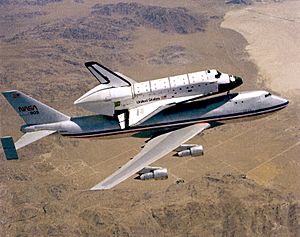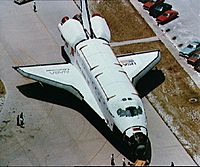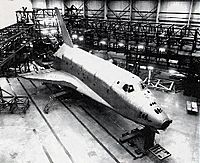Space Shuttle Challenger facts for kids
Quick facts for kids Challenger |
|
|---|---|
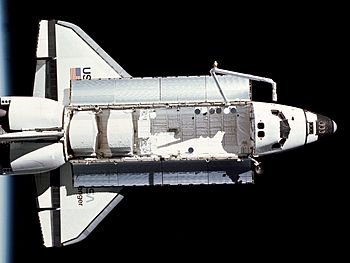
Challenger in orbit in 1983, during STS-7
|
|
| Type | Spaceplane |
| Class | Space Shuttle orbiter |
| Manufacturer | Rockwell International |
| Technical details | |
| Dry mass | 80,600 kilograms (177,700 lb) |
| Flight history | |
| First flight | STS-6 April 4–9, 1983 |
| Last flight | STS-51-L January 28, 1986 |
| Flights | 10 |
| Fate | Disintegrated during launch |
The Space Shuttle Challenger (also known as OV-099) was a special type of spacecraft called a Space Shuttle orbiter. It was built by Rockwell International and flown by NASA, the U.S. space agency.
Challenger got its name from a British ship that explored the world in the 1800s. It was the second Space Shuttle to fly into space, after Columbia. Its first trip was in April 1983.
Sadly, Challenger was destroyed in January 1986, just after it launched. All seven astronauts on board died in the accident.
Challenger was first made to be a test vehicle on the ground. It helped engineers test how strong the Space Shuttle's design was. But NASA found that it would be cheaper to make Challenger ready for space than to upgrade another shuttle, Enterprise. So, Challenger became a working spacecraft.
Engineers learned from the first flights of Columbia. This helped them make Challenger lighter. It had fewer heat shield tiles and lighter parts. This made Challenger about 1,000 kilograms (2,200 pounds) lighter than Columbia.
During its three years of flights, Challenger went on ten missions. It spent over 62 days in space and orbited Earth almost 1,000 times. It was the busiest shuttle for a while.
Challenger launched many satellites for civilian use. These included the first U.S. tracking satellite and communication satellites. It also helped test the Manned Maneuvering Unit, a backpack that let astronauts fly freely in space. Challenger even helped fix a broken telescope called SolarMax.
In 1985, Challenger carried three Spacelab missions. These were special labs that fit inside the shuttle to do science experiments. One of these missions was the first German crewed spaceflight.
Challenger also carried many important "firsts" into space. These included the first American female astronaut, the first American female spacewalker, the first African-American astronaut, and the first Canadian astronaut.
On its last flight in January 1986, Challenger broke apart 73 seconds after liftoff. All seven crew members died. This included Christa McAuliffe, who would have been the first teacher in space.
An investigation found that a seal in one of the shuttle's solid rocket boosters failed. Hot gas leaked out, causing the external fuel tank to break apart. The shuttle then disintegrated because of the strong forces.
The accident led to big changes in the Space Shuttle program. Many plans were stopped to make sure astronauts would be safer. Most of the pieces of Challenger are now buried at Cape Canaveral. One piece is on display at the Kennedy Space Center Visitor Complex.
Contents
History of the Challenger
The Space Shuttle Challenger was named after HMS Challenger. This was a British ship that explored the oceans from 1872 to 1876. The Apollo 17 Lunar Module, which landed on the Moon in 1972, was also named Challenger.
Building a Space Shuttle
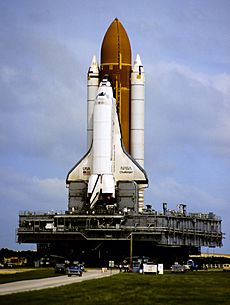
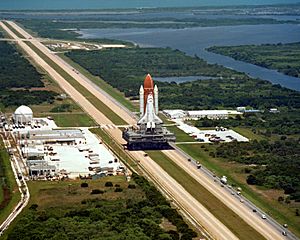
Because NASA didn't build many Space Shuttles, they decided to make one vehicle as a "Structural Test Article" (STA-099). This vehicle would be used for ground tests and could later be turned into a spacecraft.
Building STA-099 started in 1972 and finished in 1978. It then spent over 11 months being shaken and tested to see how it would handle a real space flight. These tests made sure the shuttle's structure was strong enough. STA-099 was mostly a complete shuttle body, but it had a fake crew cabin and some insulation.
NASA first planned to turn the prototype shuttle Enterprise into a working spacecraft. But Enterprise was missing many important parts needed for flight, like engines and life support. It would have been too hard and expensive to upgrade it.
Since STA-099 was already built for strength tests, it was easier to turn it into a flight-ready orbiter. So, work began in 1979 to convert STA-099 into Challenger. This included building a real crew module and reinstalling many parts. The new orbiter, Challenger, was ready in July 1982.
Challenger was built with fewer heat shield tiles than Columbia. It also used lighter materials for its body and wings. These changes made Challenger able to carry more cargo into space. It was also the first shuttle to have a head-up display for landing and more powerful main engines.
Building Milestones
Here are some key dates in Challenger's construction:
| Date | What Happened |
|---|---|
| 1978 February 14 | Rolled out from the factory as a test article (STA-099) |
| 1982 June 30 | Rolled out from the factory as the Space Shuttle Challenger (OV-099) |
| 1982 July 5 | Delivered to Kennedy Space Center |
| 1983 April 4 | First Flight (STS-6) |
| 1986 January 28 | Broke apart (STS-51-L) |
Flights and Changes
After its first flight in April 1983, Challenger became very busy. It flew six out of nine Space Shuttle missions in 1983 and 1984. Even when other shuttles joined the fleet, Challenger flew three missions each year from 1983 to 1985.
Challenger was changed to carry a powerful upper stage rocket called the Centaur-G. This rocket would have helped launch probes to distant parts of space. If its last mission had been successful, Challenger would have used the Centaur to launch a probe to study the Sun.
Challenger carried the first American woman, African-American, Dutchman, and Canadian into space. It also flew three Spacelab missions and performed the first night launch and night landing of a Space Shuttle.
Final Mission and Accident

STS-51-L was Challenger's tenth and last flight. It was supposed to launch on January 26, 1986, but faced several delays. This mission was very famous because one of the crew members was a civilian schoolteacher, Christa McAuliffe. She was going to teach lessons from space as part of NASA's Teacher in Space Project.
Challenger launched at 11:38 am EST on January 28, 1986. Just over a minute into the flight, a faulty seal in one of the solid rocket boosters failed. This caused a flame to burn through parts of the shuttle's External Tank. The tank then broke apart, and the strong forces of the air destroyed the orbiter. All seven astronauts died.
Challenger was the first Space Shuttle to be destroyed in an accident during a mission. Most of the pieces of the shuttle are buried in old missile silos at Cape Canaveral Air Force Station. A piece of the fuselage is also on display at the "Forever Remembered" memorial at the Kennedy Space Center Visitor Complex in Florida. Sometimes, pieces of the shuttle still wash up on the Florida coast.
Because it was lost early, Challenger never had the newer "glass cockpit" displays. It also never had a drag chute on its tail, which was added to other shuttles later. Challenger and Columbia are the only two shuttles that never visited the Mir Space Station or the International Space Station. In 2020, Netflix released a four-part series called Challenger: The Final Flight about the tragedy.
Support for Families
After the accident, the U.S. government and Morton Thiokol Inc. (who made the faulty rocket boosters) agreed to provide financial support to the families of four of the seven Challenger astronauts. This was done to help the families and avoid long legal battles.
List of Missions
Here are the missions Challenger flew:
| # | Date | Mission Name | Launch Pad | Landing Spot | What Happened | Time in Space |
|---|---|---|---|---|---|---|
| 1 | April 4, 1983 | STS-6 | LC-39A | Edwards Air Force Base | Launched a tracking satellite. First spacewalk from a Space Shuttle. | 5 days, 00 hours, 23 minutes, 42 seconds |
| 2 | June 18, 1983 | STS-7 | LC-39A | Edwards Air Force Base | Sally Ride became the first American woman in space. Launched two communication satellites. | 6 days, 02 hours, 23 minutes, 59 seconds |
| 3 | August 30, 1983 | STS-8 | LC-39A | Edwards Air Force Base | Guion Bluford became the first African-American in space. First shuttle launch and landing at night. | 6 days, 01 hours, 08 minutes, 43 seconds |
| 4 | February 3, 1984 | STS-41-B | LC-39A | Kennedy Space Center | First untethered spacewalk using the Manned Maneuvering Unit. | 7 days, 23 hours, 15 minutes, 55 seconds |
| 5 | April 6, 1984 | STS-41-C | LC-39A | Edwards Air Force Base | Repaired the Solar Maximum Mission telescope. | 6 days, 23 hours, 40 minutes, 07 seconds |
| 6 | October 5, 1984 | STS-41-G | LC-39A | Kennedy Space Center | First mission with two women. Marc Garneau became the first Canadian in space. Kathryn D. Sullivan became the first American woman to do a spacewalk. | 8 days, 05 hours, 23 minutes, 33 seconds |
| 7 | April 29, 1985 | STS-51-B | LC-39A | Edwards Air Force Base | Carried Spacelab-3 for science experiments. | 7 days, 00 hours, 08 minutes, 46 seconds |
| 8 | July 29, 1985 | STS-51-F | LC-39A | Edwards Air Force Base | Carried Spacelab-2. Only shuttle mission to have an engine shutdown after launch. | 7 days, 22 hours, 45 minutes, 26 seconds |
| 9 | October 30, 1985 | STS-61-A | LC-39A | Edwards Air Force Base | Carried German Spacelab D-1. Wubbo Ockels became the first Dutchman in space. | 7 days, 00 hours, 44 minutes, 51 seconds |
| 10 | January 28, 1986 | STS-51-L | LC-39B | Did not land | First mission with a private citizen (Christa McAuliffe). Broke apart after launch, killing all seven astronauts. | 0 days, 00 hours, 01 minute, 13 seconds |
Mission Patches and Tributes
| Mission patches for Challenger flights | |||||
|---|---|---|---|---|---|
| STS-6 | STS-7 | STS-8 | STS-41-B | STS-41-C | STS-41-G |
| STS-51-B | STS-51-F | STS-61-A | STS-51-L | STS-61-F* | |
* This mission was planned but canceled because Challenger was lost on STS-51-L.
See Also
 In Spanish: Transbordador espacial Challenger para niños
In Spanish: Transbordador espacial Challenger para niños


